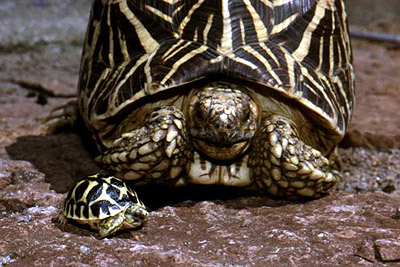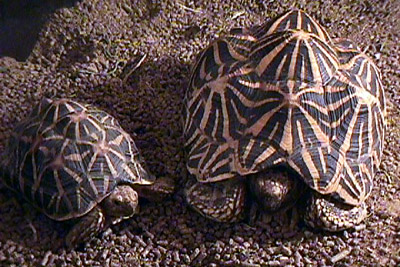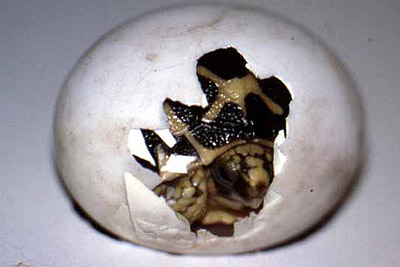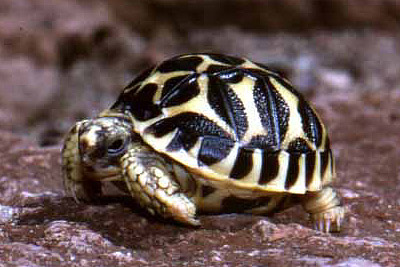

Introduction
The Star tortoise belongs to a group of tortoises that bear a distinguishing radiating pattern on their carapaces. Variations of this pattern are quite common among African and to some extent Asian tortoises, and are - despite the eye-catching appearance in unnatural surroundings - a very efficient means of camouflage. Among the 'starred' group of tortoises are the Radiated, Spider and Flat-shelled tortoises of Madagascar and the Geometric and Tent tortoises of southernmost Africa. All the starred beauties have since the early days of herpetoculture been much sought after among tortoise enthusiasts and commercial trade, legal as well as illegal has together with the ever-present habitat destruction led to all these species becoming locally or regionally threatened. The starred species that traditionally has been the most common in captivity is the Star tortoise, much due to an historical extensive trade in wild caught specimens mainly from Sri Lanka.
Description
SIZE: Geochelone elegans is a medium to large size tortoise. The specimen that so far holds the size record was a female from the northern part of the species' distribution area, which weighed 7 kilograms and measured 380 mm SCL, but most specimens are considerably smaller. Females are much larger than males, who seldom reach sizes over 200 mm SCL. In adults the sexual dimorphism is striking. Aside from the difference in size, females have a more rounded appearance, and the males tail is much larger than that of the female. In addition to these characteristics, males have a concave plastron while the plastron of a female is completely flat and the gap between the anal and supracaudal plates is larger in females. Recently, I received information about a supposed male, kept in captivity in Maharashtra in India but originally from Jamnagar district of Gujarat, which weighs as much as 10 kilograms.
APPEARANCE: The ground colour of the shell is light cream to dark yellowish brown, and a number of wedge-shaped black fields on each scute form the characteristic star pattern. In this, the Star tortoise differs from certain others of the starred tortoises, e.g. the Radiated tortoise, which has a dark ground colour with light markings. This fact is easily illustrated by the fact that while ageing radiated tortoises grow very dark due to the radiating pattern being lost by wear, old star tortoises tend to become increasingly yellow as the black fields are worn out.

The Star tortoise can, contrary to many other tortoises, but together with certain other species in the subfamily Geochelone (among them G. pardalis) possess a shell with naturally raised scutes, something which looks similar, but not identical to the pyramiding often seen in tortoises marked by malnutrition and poor husbandry. This feature is highly variable in the Star tortoise - both smooth and quite bumpy specimens exist in the same populations. The cause or function of this phenomenon is unclear - it might be a genetic trait, or it could simply be a result of individual differences in diet composition or access to food. Sometimes, one hears explanations about how mainly Sri Lankan Star tortoises have bumpy shells and that 'smooth' stars are mainland animals, but I have personally seen smooth shelled Sri Lankan animals, and I have also seen bumpy wild Star tortoises in the north-western parts of the Indian subcontinent. Personally, I suspect that the theory about Sri Lankan animals being significantly more bumpy works as a means for less serious dealers in the advertising of animals who have pyramided due to bad husbandry - it makes sense that it is easier to sell '…a healthy and well built specimen of Sri Lankan type' than '…a specimen with a malformed shell, caused by long-term incorrect husbandry'.
The anterior part of the front legs are covered by large scales, while the hind legs lack this protection. The soft parts of this species is creme-yellow to yellow, with a varying amount of dark brown or black irregular spots. The Star tortoise has 5 claws on each foot, and the posterior claws of females are markedly longer than male hind claws, and more curved - this is to facilitate nest excavation in the often hard and dry ground. The head is speckled with black.
Distribution and local variation.
The species ranges over large parts of India, in South-eastern Pakistan (SE Sind) and in Sri Lanka. At least three geographically separated variants can be perceived, and there is a distinct possibility that the species will be divided into several subspecies, or maybe even seperate species in the future.
Star tortoises from the northern parts of the Indian subcontintent (Gujarat, Rajasthan, Uttar Pradesh and Pakistan) are very large and have a relatively dark ground colour. The 'black' fields of the shell are often more brown than black. These animals give a 'dirty' appearance compared to specimens from the southern populations. Animals from the southern parts of the subcontinent (Tamil Nadu, Kerala and Karnataka) are much smaller than their northern relatives, have a more contrasting pattern with a creme-yellow ground colour and jet black dark fields. Sri Lankan specimens look much like the animals from the southern mainland, but grow nearly as large as the animals from northern India and Pakistan.
Status in the wild.
THREATS: During the past century the Indian nature has been subjected to considerable strain. An accelerating aggressive use of forests and other natural resources has together with the increasing demand for agricultural land to satisfy the basic needs for the rapidly growing population led to the destruction of large areas of what once was suitable habitat for the star tortoise. In addition to this, the tortoises are used as food in parts of India - a tradition that will work just fine while the human population is relatively low, but will quickly endanger a slow growing and slow reproducing species like the star tortoise when the density of human population grows quickly. The crucial difference between the Indian situation and the situation in China, where chelonians seem to have no future is that tortoises in India are consumed almost exclusively by people of very low income - often tribals. This makes the economic growth and raised national income a positive factor in India - as more people can afford to eat other foods, less tortoises will likely be consumed.
Added to the threats of habitat loss and utilisation for human consumption is the commercial trade, often illegal, in wild caught Star tortoises. In India as well as in Southeast Asia (Hongkong, Singapore) and in the Gulf states (Dubai, Oman, UAE), wild caught specimens, mainly juveniles, can be found in just about every animal market. A conservative estimate is that the yearly toll on the Indian populations is 10-20000 specimens. The species has been placed on CITES appendix II, which regulates the legal international trade, and it is also protected under the Indian Wildlife Act from 1972, where it has been placed under Schedule IV, making it illegal both to possess and trade in Star tortoises inside India without a permit. Sadly, the enforcement of this law seems to be lacking, as star tortoises are still openly offered for sale in pet shops, e.g. in Mumbai's Crawford market. There has been no legal large-scale exportation of Star tortoises from India for many years, and there is no indication that such exports will again be permitted.
STATUS: The Star tortoise still has a fairly large range, but suitable habitats are being destroyed and rendered useless for the species. Taken into account that the taxonomic status as an entity is uncertain, the eradication of Star tortoises from any larger area could, at least theoretically, mean the extermination of an undescribed subspecies or even species. It is therefore of greatest importance that remaining populations all over the species range are studied and protected. The present status of the species is unclear, and since very few reliable accounts on its historical distribution exists, it is hard to appreciate how the Star tortoise will fare in the future. One thing that is certain is that the species faces great problems in anything but nature reserves if the human population in India keeps rising as quickly as it is has done over the last 50 years.
Natural history
HABITAT: Geochelone elegans is found in a number of habitat types - from the semideserts in the outskirts of the Thar area in Rajasthan and Gujarat to the savannahs and the more moist deciduous forests of southern and western Sri Lanka. In Sri Lanka, many forests drop their leave during the dry period of the year. The most distinguishing common feature of all Star tortoise habitat is its dryness - it may be dry for three months or ten, but part of the year is always dry. The species also needs some sort of protection from the burning rays of the midday sun - this protection can consist of vegetation, rocks or even planted hedges. No comprehensive studies have been done on the population density of the Star tortoise, but the existing data implies that the density varies greatly between different habitat types. In central India, the figure 1 tortoise/km. sq. has been mentioned, while the density for central Gujarat has been estimated to 4-12.5 individuals/hectare.
DIET: The Star tortoises natural diet is predominantly vegetarian. It consists mainly of different grasses, but the species does consume carrion and insects when given the opportunity. In the drier habitat types fresh grass is only available during and shortly after the monsoon period. During the long periods of drought and (relative) cool weather, the Star tortoise is rather inactive, and it can go without food for long periods of time.

Reproduction
MATING: The mating season of the species correlates with the monsoon, which in Northern India lasts from late June to September. Unlike many other tortoises, male star tortoises seldom or never engage in male-male combat, nor do they show butting, biting or ramming behaviour towards females. The actual mating is a pretty quiet affair compared to other tortoises, but the male does emit a grunting sound during the time. In 60-90 days after mating, the female usually is ready to lay the first of several clutches.
EGG LAYING: As with other female gravid tortoises, a Star tortoise ready to lay is restless and aggressive towards companions. Star tortoises can be particularly choosy when it comes to finding an acceptable spot to lay in - it must not be too damp or too dry, the soil must be diggable, and it must also show characteristics that indicate that it will not become waterlogged, too hot or too dry in the Indian climate. Once she has found a suitable spot, she digs a flask shaped nest, approximately 15 centimetres deep, with her back legs. If the soil is too hard and dry, she will wet the spot by emptying her bladder. She then proceeds to lay a clutch of 1-6 eggs in the excavated nest, replaces the soil with her back legs and flattens the spot with her plastron. There are reports of Star females nesting in leave mounds in captivity, but it is possible that this is a behaviour forced by the lack of suitable nesting places.
HATCHING: The eggs of the Star tortoise measure appr. 35*45 mms, are hard-shelled and weigh 25-45 grams. The eggshell is quite different from Testudo-eggs, being significantly thinner and much more brittle. If viewed under magnification, the structure of the eggs is markedly porous. When newly laid the eggs are translucent, but under the first 2-3 weeks they whiten, starting with a 'waistband' of chalky coloration. Incubation time is very variable. The shortest reported time from oviposition to hatching as a mere 47 days, and the longest 223. Most eggs in captivity hatch at 90-120 days when incubated in 29-31 degrees centigrade. The newly hatched young are 35-45 mms long SCL, and lack the typical star pattern of the adults - they are either completely yellow, or black with a yellow 'butterfly' pattern on each carapacial scute. Sex determination in G. elegans seems to be dependent upon incubation temperatures. The threshold temperature is said to be 30.5 C. Incubation temperatures below this (such as 28-30 C) will produce mainly males, while higher temperatures 31-33 C) will produce mostly females.

The hatchlings normally grow rapidly for the first few months, and then settle down to a slower growth rate. Maturity in nature is attained at 6-8 years of age in males and at 8-12 years in females. In captivity, maturity can be reached far earlier, but then usually at the cost of unnatural growth and among extremely quick-raised animals probably locomotion difficulties and reproductive problems in females. I am sure there a 'golden compromise', where growth is reasonably rapid and no health risks are involved, but it is hard to understand why rapid growth would be important enough to justify experimenting on these animals - it is far better to aim for a replication of natural growth patterns.
Care in captivity
GENERAL: Keeping G. elegans successfully in northern climate is a challenge. The Star tortoise has a reputation of being particularly sensitive and fragile, and I must agree that this is at least partly true. Success is however not impossible if one keeps a few basic principles in mind: the species is extremely sensitive to respiratory problems if kept too cold or too damp; it is also very vulnerable to protozoans like Hexamita and Trichomonas. Star tortoises also seem to be more sensitive to problems caused by exposure to other species of tortoises, why a strict isolation is crucial in Star tortoise husbandry. Many reptiles can carry pathogens that are potentially lethal to Star tortoises without displaying any symptoms themselves - new data indicates that tortoises can carry lethal organisms this way for over 10 years. Wild caught Star tortoises generally adapt very slowly if at all to captivity, especially to the more unnatural conditions that are necessary when keeping them in northern climates.
ENCLOSURE: The Star tortoise has much the same needs as its close relative the Leopard tortoise - a dry and warm environment, but since G. elegans is a less active species, and does not attain the 'giant' size of the Leopard tortoise, a smaller indoor area can be acceptable. Nevertheless, when planning indoor facilities for Star tortoises, it is wise to bear in mind that they will not be able to spend as much time outside as other tropicals, why the enclosure should be made fairly large anyway. An absolute minimum would be 1-2 meters sq. I use a heating pad, controlled by thermostat to 22 degrees Celsius to provide a base heat in part of the cage during the winter. It is important not to rely only on undertank heating, as this is not natural for the tortoise, and can cause gut problems. As a source for basking heat I use 40W clip-on spots and ceramic heat emitters. The daytime ground temperature under the basking lights is 38 degrees Celsius.
DIET: As mentioned above, the diet of the Star tortoise is essentially herbivorous in the wild, and there is no reason to change this in captivity. In nature, where food availability during the dry periods is extremely low, it is understandable that a tortoise consumes animal matter when found, but in captivity, where food is plenty, offering animal foods is downright dangerous. I have during the last 6-7 years kept Star tortoises in captivity, and the main part of their diet consists of grass. During the summer months I let the animals graze freely in their outdoor enclosures, and during winter and spring I use cut grass and mixed wild weeds supplemented with Opuntia pads. When I have no access to wild food I give them Romaine, and other leafy greens mixed with dried grass and herbs. I supplement regularly with calcium and there is always cuttlebone in the enclosures. During spring and summer, when the animals can spend time outside, I give no vitamin supplement, but in the indoor period I supplement with a vitamin product containing D3.
COMMON HEALTH PROBLEMS: If the tortoise should come down with a respiratory infection and the results of the culture and sensitivity test shows that a course of antibiotics is necessary, it might be useful to be aware that G. elegans seems to be allergic to one of the more popular reptile antibiotics. The drug in question is Baytril®, and the active ingredient is Enrofloxacin. The 'allergy' causes a massive saliva and tear production, and evident pain in at the injection site. The treated animal seems to be in distress during all of the treatment time, and generally refuses to feed during the course of the treatment. Despite this, the drug does acheive results, so if no other antibiotic is suitable or the animals kidney status is too bad to allow the use of a more suitable but nephrotoxic drug, Baytril® can still be used - but with some extra care. Similar reactions have been reported in some specimens of G. pardalis.
Final words
The summer climate of southern Sweden (or the Midwestern US, for that matter) can under the best of summer days be quite similar to a dry monsoon day in the coastal areas of Northwestern India. Letting the tortoises outside for grazing under these circumstances is a very efficient way of inducing mating behaviour. The long period of dry indoor accommodation during the winter also mimics the Indian hot and dry season and acts as a natural period of drought. With some good planning and a well-thought out strategy for indoor husbandry these true jewels of the Indian crown can be successfully kept over long periods of time and for generations. I cannot recommend the Star tortoise to someone who simply 'want a tortoise', but for the dedicated hobbyist, the combination of relative small size, beauty and interesting behaviour hard to beat. Since it is also the species among the 'true starred tortoises' that is least threatened, G. elegans is suitable out of practical needs as well. Captive bred specimens are being produced in greater numbers yearly, so it is also possible to make an environmentally and ethically correct purchase.
Further reading
- Daniel, J.C. (1981). The book of Indian Reptiles. Bombay: Bombay Natural History Society.
- Das, I. (1991). Colour Guide To the Turtles and Tortoises of the Indian Subcontinent. Portishead: R&A Publishing Ltd.
- Das, I. (1995). Conservation Problems of Tropical Asia's Most-Threathened Turtles. In: Van Abbema, J. Proceedings: Conservation, Restoration, and Management of Tortoises and Turtles - an International Conference. New York: State Univ. of New York, Purchase.
- Frazier, J.G. (1995). Management of Tropical Chelonians: Dream or Nightmare? - part 2. In: Van Abbema, J. Proceedings: Conservation, Restoration, and Management of Tortoises and Turtles - an International Conference. New York: State Univ. of New York, Purchase.
- Rasmussen, V. (1989). Stjerneskildpadder i familjen. Nordisk Herpetologisk Forening 4 (32)
- Tikader, B.K. & Sharma, R.C. (1985). Handbook Indian Testudines. Calcutta: Zool. Survey of India.
- Whitaker, R. & Andrews, H.V. (1995). Captive Breeding of Indian Turtles and Tortoises at the Centre for Herpetology/Madras Crocodile Bank. In: Van Abbema, J. Proceedings: Conservation, Restoration, and Management of Tortoises and Turtles - an International Conference. New York: State Univ. of New York, Purchase.